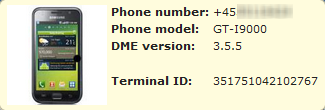
The Phone model column shows information about the devices that are managed by DME. Each device is named by the make and model of the device.
If you let the mouse pointer rest on a device link, a box will appear with more information about the current device:

The information derives from the DME database, and can be edited in the Device setup panel. To edit the device, double-click the line in which the device is displayed, or select the device and click View device info in the page menu. For more information, see Setting up devices.
Each device is identified by a unique ID, which is the IMEI number of the device. If the device does not contain a phone module, the ID will be the MAC address of the device. Please also note that due to Apple API restrictions, iOS devices do not report their IMEI number. Instead, a unique ID is shown.
The Phone model column may contain the following icons:
|
If the icon is followed by a model name, this is a device being managed by DME. It is associated with the user on the current line (if any). |
|
This device is currently connected using network push. |
|
This device has been bootstrapped/enrolled. The icon can be combined with the network push icon above as well. |
|
The device is currently synchronizing with the server. |
|
The device is blocked. Perhaps the associated user is under notice. See Toggle device lock. |
|
If the column shows no icon, the user on the current line does not currently hold a device. |
The icon is followed by the device type. This is the type reported by the device. The DME client may adjust or change the device type. For instance, the client adds (Jailbroken) to iPhone devices that have been jailbroken (and thus not formally supported), and adds (Rooted) to rooted Android devices. Such devices can be locked automatically by DME - see Authentication.